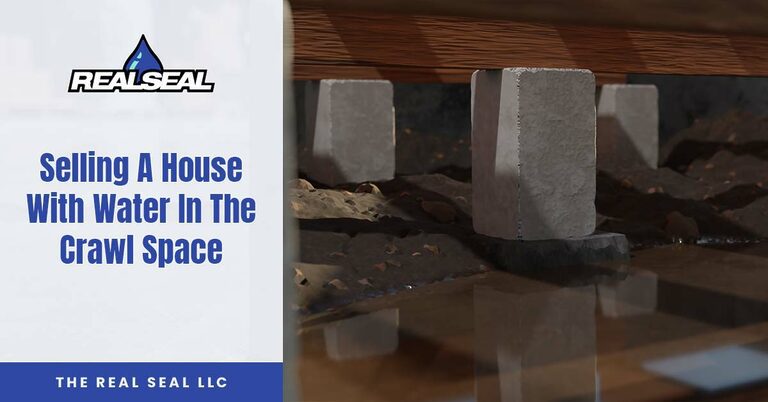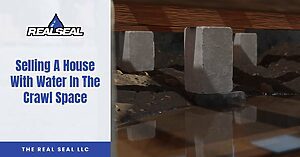Looking for information about selling a house with water in the crawl space? If so, don’t hit that back button because you’re in the right place. In this article, we’ll review how water gets into a crawl space, why you don’t want water in your home’s crawl space, how to fix a wet crawl space, selling a house with water in the crawl space, and more.
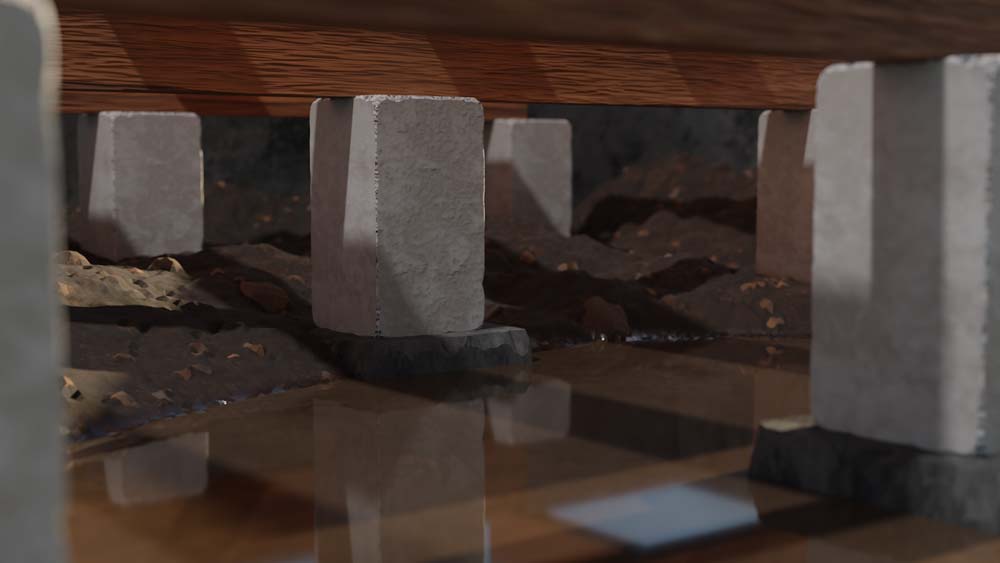
How Does Water (and Moisture) Get Into a Crawl Space?
- Through the foundation walls and floor – One of the primary ways water enters crawl spaces is through the foundation walls and floor. Groundwater is a major source of moisture in crawl spaces, particularly in areas with high water tables. As water saturates the soil around the foundation, it can seep through the porous concrete walls and floor of the crawl space. This can also occur when there are cracks in the foundation or gaps around utility penetrations, allowing water to enter.
- Through open vents – Water can enter through the open crawl space vents, particularly during heavy rainfall or flooding. This can lead to standing water in the crawl space, which can cause significant damage if not addressed promptly.
- Problems with gutters and downspouts – Faulty gutters and short downspouts can also contribute to water infiltration in crawl spaces. When water isn’t correctly directed away from the foundation, it can seep into the soil and ultimately enter the crawl space.
- Poor drainage around the foundation – If the ground around your home is soggy, your crawl space is going to have excess moisture.
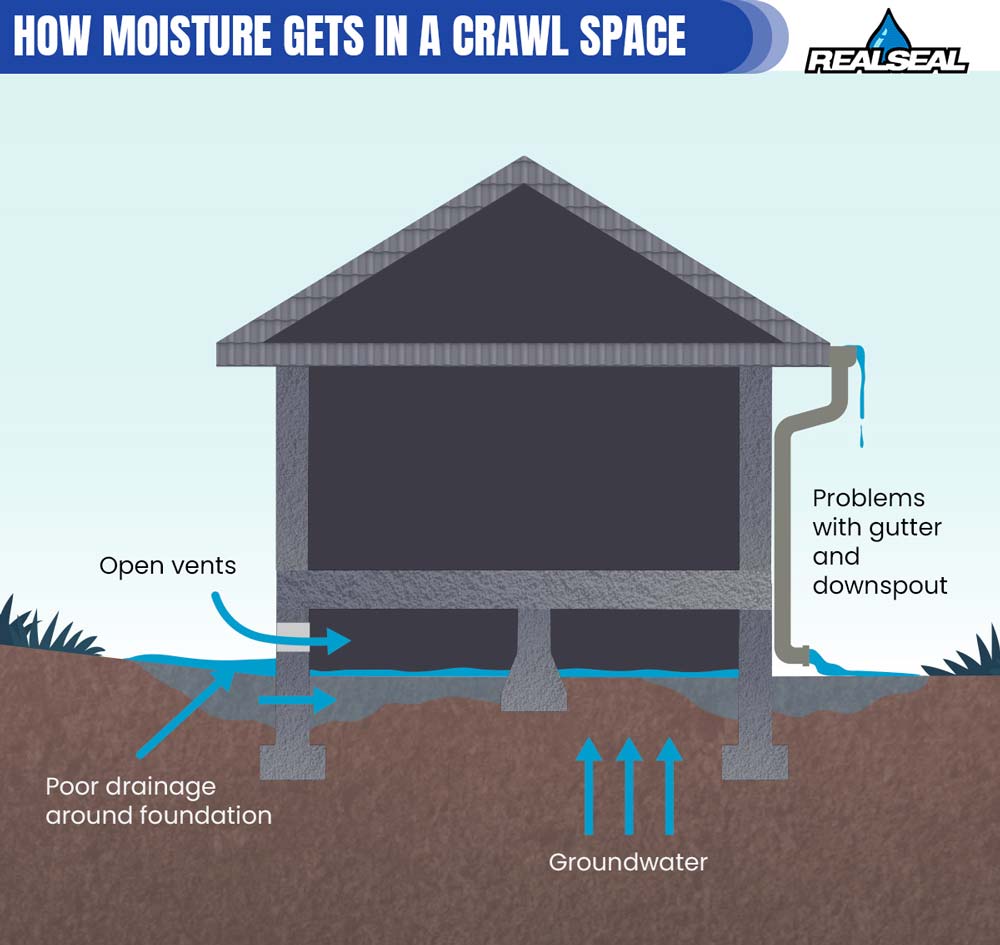
Preventing water infiltration in crawl spaces requires a multi-faceted approach, including proper drainage and grading around the foundation, sealing all openings and cracks, and encapsulation. Regular inspection and maintenance of the crawl space can help identify and address any moisture issues before they cause significant damage.
Why You Don’t Want Water in the Crawl Space
The presence of water in a crawl space can lead to a multitude of problems for homeowners, including the following:
- Mold growth – Water can lead to mold growth, which can cause respiratory problems for those living in the house. This can be especially dangerous for those with preexisting respiratory issues or compromised immune systems. Mold can also cause significant damage to the wooden structures in the crawl space, which literally hold up your house.
- Pest infestation – Water can also attract pests such as termites, carpenter ants, snakes, and rodents. These pests – which can be difficult and expensive to exterminate – can cause significant damage to the crawl space beams, joists, wiring, insulation, etc. Standing water can also create a breeding ground for mosquitoes and other insects, which can further contribute to the spread of dangerous diseases, such as West Nile virus, Lyme disease, and Zika virus.
- Rust – Excess moisture can also cause anything in the crawl space made of metal to rust.
How to Know if There’s Water in Your Crawl Space
Signs there’s water in your home’s crawl space include the following:
- Visible standing water – One of the most obvious signs of water in the crawl space is standing water. If there has been recent rainfall or the area hasn’t been properly sealed, water may accumulate in the crawl space and create puddles.
- Visible mold – You may see mold in the crawl space, on the wooden beams, joists, insulation, etc. In some cases, mold will spread from the crawl space to the wooden floor and baseboards on the floor above the crawl space.
- Moisture – Homeowners can check for moisture by placing a plastic sheet on the ground in the crawl space and leaving it for 24 hours. If there’s condensation on the underside of the plastic sheet, there’s likely moisture present in the area.
- Damaged wood and rusted metal – Also, look for signs of damage to the crawl space itself, which can result from moisture buildup. Visible signs of damage may include warped or rotting wood and rusted metal.
- Musty smell – Additionally, you may notice a musty odor emanating from the crawl space, which can also indicate the presence of moisture. Your home’s living area might even smell musty.
- High indoor humidity – Excess moisture in a crawl space can cause increased humidity inside your home’s living area.
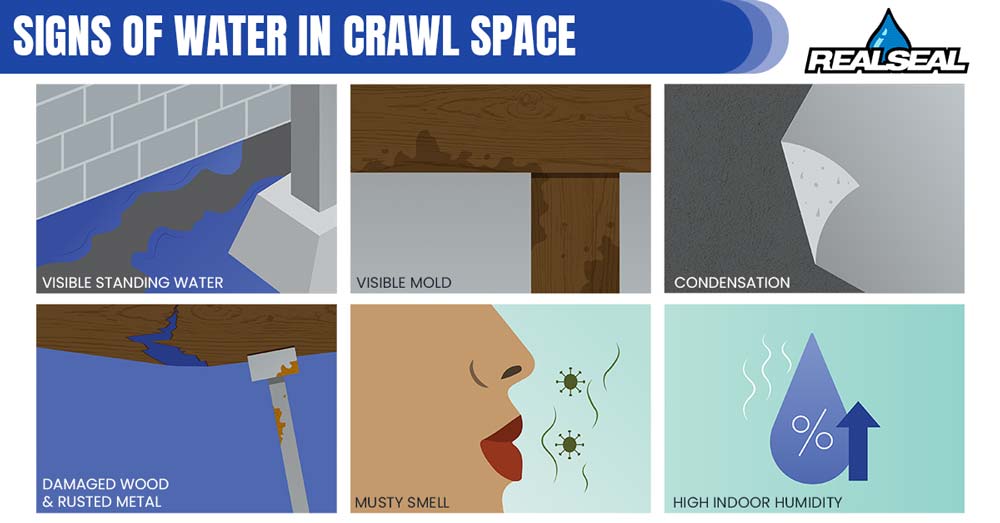
The best way for homeowners to determine if water is present in their crawl space is to have a foundation repair professional inspect the area. A professional can not only identify the presence of water and moisture, but they can also provide recommendations for remediation to prevent further damage.
How to Fix a Wet Crawl Space
The best way to fix a wet crawl space is to contact a foundation repair professional with experience fixing crawl spaces and ask for an evaluation. We don’t recommend a DIY approach because fixing a wet crawl space is a lot of work if you want to do it correctly and have the repair last.
How to Sell a House With Water in the Crawl Space
If you’re trying to sell a house with water in the crawl space, contact a foundation repair professional with experience fixing crawl spaces to identify the source of the water in the crawl space. Is it from a leaky pipe, poor drainage around the foundation, heavy rain, or something else? Once the source has been identified, request a report detailing the necessary repairs. This will give potential buyers a clear understanding of what they are getting into and help to establish trust between buyer and seller. It’s essential to be upfront and honest about any issues with the property to avoid any legal repercussions.
Of course, the best way to handle the situation is to fix the problem before listing your home. That way, you won’t need to disclose any problems, because there aren’t any!
How to Help Prevent Water From Entering a Crawl Space
The good news is there are simple and effective ways to help prevent water from entering crawl spaces. These include the following:
- Ensure that gutters and downspouts are properly installed, in good condition, and functioning correctly. Gutters should be clean and debris-free, and downspouts should divert water at least 15 feet from the foundation before release. This may mean installing downspout extensions.
- Another key factor in preventing crawl space water intrusion is adequate grading. The ground near the foundation should slope away from the house to prevent water from accumulating and seeping into the crawl space.
- Installing a drain tile system is an excellent way to help keep water out of the crawl space. It works by preventing excess moisture from building up in the ground around the foundation.
- Crawl space encapsulation will ensure the crawl space stays both clean and dry. This involves sealing the crawl space vents and covering the floor and walls of the crawl space with a thick, vapor-retarding barrier.
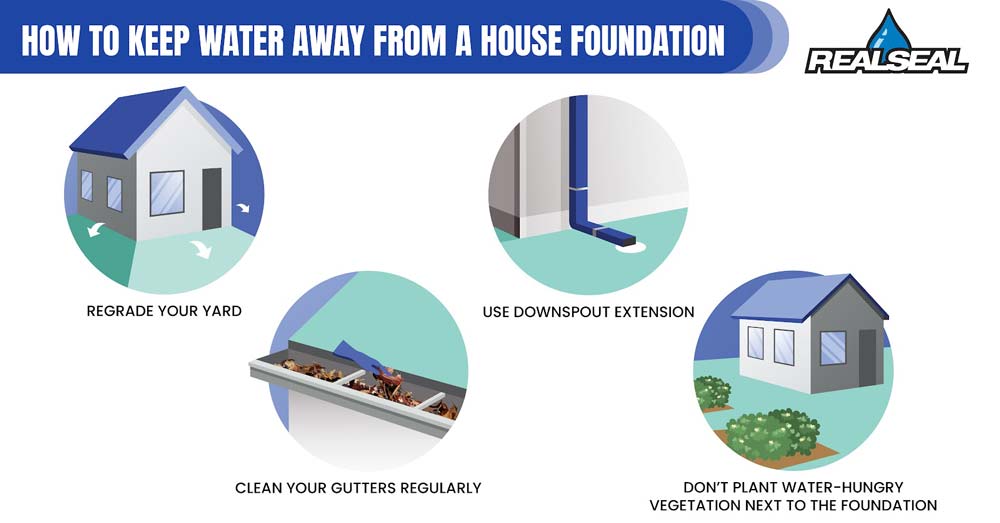
If you’re considering selling your Chicagoland home and are worried about water in the crawl space, contact us today to schedule an evaluation and receive a repair estimate.
